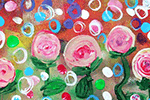The Children's Art Book
Air Dry Clay Techniques
It gives for a fantastic workout for children, and for families, a fun and therapeutic experience!
In this article, we refer to air dry modelling clay, which are soft and pliable but dries hard and stays permanent. They do not require firing, and are suitable for most schools and homes without a kiln.
Clay Tools
Most parents put off exploring clay with their children due to unfamiliarity with the tools. Children should be comfortable working with clay with their hands before learning to handle tools. When it’s time for clay tools to be introduced, try out daily items you can get in your kitchen: plastic knives (or other plastic utensils), cookie or pizza cutters, toothpicks or satay sticks etc. Use old glass bottles as rollers, as they are sturdy and suit young children with smaller fingers.
Other items around the house suitable as starter clay tools:
- Pebbles from the garden (washed cleaned), which make good round indentations
- Combs, leaves, old toothbrushes or any other patterned surfaces for printing and impressions
- Paper clips or pencils, for scoring lines and waves
- Clean wires or fishing lines, as a clay cutter
Purchase clay tool kits for older children who have the dexterity and fine motor skills to control them safely and confidently.
Don’t forget to cover the clay work area with plastic wrapping sheets or newspaper. Children should wear smocks or old clothing for protection. It’s going to get messy!
Working with Clay
Prepping Clay Balls
Most air dry clay sold in Singapore come in thick slabs. In this form, young children will find it challenging to begin their clay work. Clay balls are perfect for toddlers to knead, pull, pinch and twist to shapes. Cut the clay slabs and roll into balls of clay, and store them in a sealed bag for use within the same day.
Prepping Clay Slabs
For larger clay works, prepare larger slabs instead of ball-size clay. Stack pre-cut slabs on top of one another with thick cardboard or paper to prevent slabs from sticking to one another. Clay slabs are ideal for making prints, impressions or shape cut-outs with cookie or pizza cutters.
For Primary school students, try creating marbled clay slabs by stacking slabs of different colours on top of another, then rolling them to a larger slab to achieve the cool marble-like folds and textures much like the cross-sections of the earth!
Storing the Clay
Prepared clay should be store moist to prevent premature hardening. Keep either in a sealed bag just large enough so that the clay is exposed to little air. For larger quantities of clay, consider storing in air tight tubs with wet cloths draped over the clay balls or slaps to maintain a moist environment. Use within a day to prevent hardening.
One effective way to label clay works is to engrave (really just writing deeply) with a pencil or clay knife on the underside or base of the clay. The engraving stays with the work and will not obstruct if you need to glaze the work.
Once the clay has began being worked into, store them in long flat plastic tubs that can serve as trays as you move the delicate works around. You don’t want the limbs to fall off through shaking before permanent hardening! If there is a trolley lying, place the plastic tubs on trollies for even more stability in transporting them.
Air drying racks are also useful if you have many clay works. Kitchen dish counter racks past its time can double up as clay racks, or build your own from grid racks from the dollar (or Daiso) store. Thicker clay and their bases dry quicker on these grid racks.
Clay Mini-Projects
Now, we are ready to get started! Once children are comfortable working from clay balls and slabs, they may be ready with more detailing.
Stick Figure
Create your own clay human figure with an aluminium foil armature. Crush, mash and twist a few pieces of foil together to form a stick figure in your desired pose. If you wish, you may strengthen your armature with steel wires (adults only please, non-child appropriate). From a clay ball, pinch out small pieces of clay and knead it flat with your finger tips. Wrap the flattened clay over the foil armature like a skin would. Smoothen the clay edges with water and more finger kneads!
Clay Pots
Not all clay pots require the potter’s wheel. There are affordable table top potter’s wheel in stores, you can create a makeshift one with just a paper plate.
For younger children, try the a clay pinch pot:
- Prepare a clay ball, about the size of an orange fruit
- Hold the clay in the ball of your palm
- With the other hand, press right into the middle of the ball with the thumb. Watch how a crater bowl of clay forms around your thumb
- Revolve the ball in one hand, while the walls are pressed out evenly with the thumb on the inside and fingers on the outside
- Continue shaping your bowl with thumb and fingers, smoothing the surface with a damn sponge until you have “pinched” out a pot!
For older children with better dexterity, make a coil pot instead:
- Beginning with a clay slab, roll and press down on the clay as you would with pizza dough
- Coil the rolls of clay by stacking up in layers, applying water and slip in between rolls as a form of adhesive
- From the inside of the coil pot, rub edges of the coils with your finger to form a clay wall
- Leave the coil pattern on the exterior untouched for the traditional cool finish!
Clay beads
Clay jewelry are one of the simplest crafts to begin with, and the easiest of them all may be clay beads.
Roll as many balls of clay, varying in sizes. If you like, make shaped (triangle, heart, oval) shape tiles to your hearts content!
Poke through a hole with a toothpick for a string or rope to run through. Allow the balls or tiles to air dry. The smaller the tiles, the quicker they dry and the faster the children can paint on them. Acrylic paint is preferred, as they are easy to work with and resistant to water when dry.
Apply clear (odourless non-toxic) on the clay for that shiny premium jewelry finish. String your clay beads or tiles up to make a necklace, bracelet, earrings, etc. and show them off proudly!
Score and Slip Technique
Score and slip is basic way of adhering pieces of clay together. In effect, slip is simply watery clay, much like a sort of slime texture. To make slip, mix clay and water together, rubbing clay with your fingers until you achieve the viscous consistency of thick cream. Add more water as required. You can make batches of slip before hand. They keep well in an airtight container.
Scoring clay areas where it adheres will make the texture bumpy, with more surface area for the sticky slip to work its magic. Score the clay with a plastic fork, toothpicks, pin or clay tools, to create many dots or cross hatched lines, and apply slip on the score lines. Place the another clay (also scored) on the slipped areas and smoothen the edges together to create a blended join.











